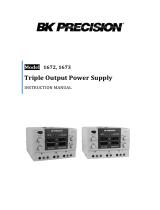
xi
Config Menu .......................................................................................................................... 18
How to Navigate the Menu ................................................................................................... 19
3.2 Configure Operation Modes (CC/CV/CR/CW) ............................................................... 20
Constant Current (CC) Mode ................................................................................................. 20
Constant Voltage (CV) Mode ................................................................................................. 23
Constant Resistance (CR) Mode ............................................................................................ 24
Constant Power (CW) Mode .................................................................................................. 25
Setting CC, CV, CR, CW Mode ................................................................................................ 27
3.3 SYSTEM Menu ............................................................................................................... 27
Restore Factory Default Settings ........................................................................................... 28
Configure Power-On State ..................................................................................................... 29
Load On Knob ........................................................................................................................ 29
Configure Trigger Source ....................................................................................................... 30
Save/Recall Instrument Settings ........................................................................................... 31
Display Input On Timer .......................................................................................................... 34
Remote Interface Setup ......................................................................................................... 34
3.4 CONFIG Menu ............................................................................................................... 37
Von Operation ....................................................................................................................... 37
Configure Protection Settings ............................................................................................... 40
Configure Timed Input .......................................................................................................... 44
Measurement Configurations ............................................................................................... 44
CR LED Function .................................................................................................................... 46
Remote Sense ........................................................................................................................ 47
External Analog Control and Monitor ................................................................................... 48
3.5 Short Operation ............................................................................................................ 50
3.6 Transient Operation ...................................................................................................... 51
Continuous ............................................................................................................................ 51
Pulse ...................................................................................................................................... 52
Toggle .................................................................................................................................... 52
3.7 List Operation ................................................................................................................ 56
Configure List ........................................................................................................................ 57
Run List .................................................................................................................................. 59
3.8 Battery Test Function .................................................................................................... 60




















